The Skylake Core i3 (51W) CPU Review: i3-6320, i3-6300 and i3-6100 Tested
by Ian Cutress on August 8, 2016 9:00 AM ESTMiddle-Earth: Shadow of Mordor
The final title in our testing is another battle of system performance with the open world action-adventure title, Shadow of Mordor. Produced by Monolith using the LithTech Jupiter EX engine and numerous detail add-ons, SoM goes for detail and complexity to a large extent, despite having to be cut down from the original plans. The main story itself was written by the same writer as Red Dead Redemption, and it received Zero Punctuation’s Game of The Year in 2014.
For testing purposes, SoM gives a dynamic screen resolution setting, allowing us to render at high resolutions that are then scaled down to the monitor. As a result, we get several tests using the in-game benchmark, taking results as the average and minimum frame rates. Minimum frame rate results can be found in Bench.
For this test we used the following settings with our graphics cards:
| Shadow of Mordor Settings | |||
| Resolution | Quality | ||
| Low GPU | Integrated Graphics | 1280x720 | Low |
| ASUS R7 240 1GB DDR3 | |||
| Medium GPU | MSI GTX 770 Lightning 2GB | 1920x1080 | Ultra |
| MSI R9 285 Gaming 2G | |||
| High GPU | ASUS GTX 980 Strix 4GB | 1920x1080 3840x2160 |
Ultra Ultra |
| MSI R9 290X Gaming 4G | |||
Integrated Graphics
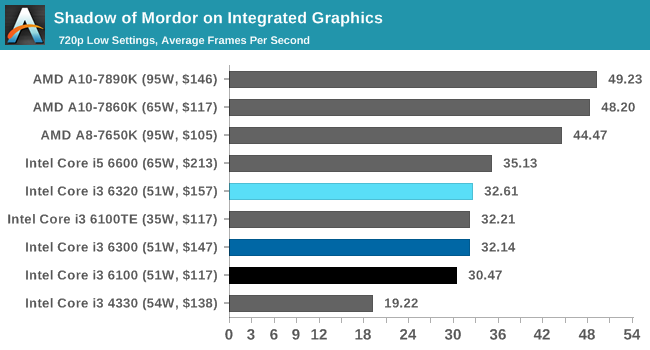
As with the other IGP tests, the APU solution gets significantly better results.
Discrete Graphics
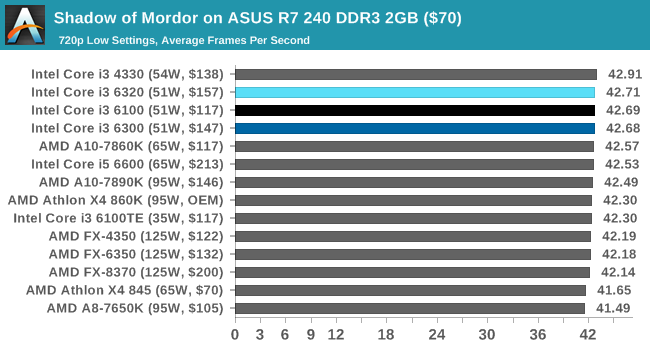
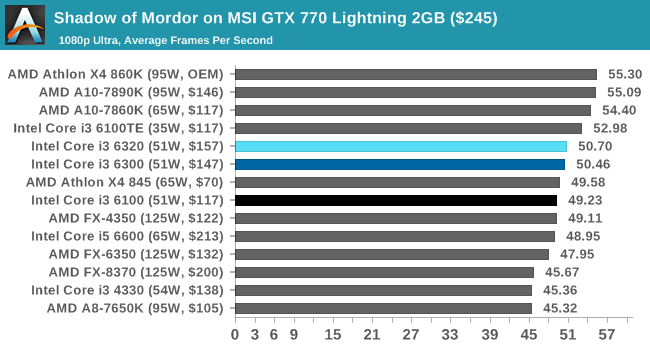

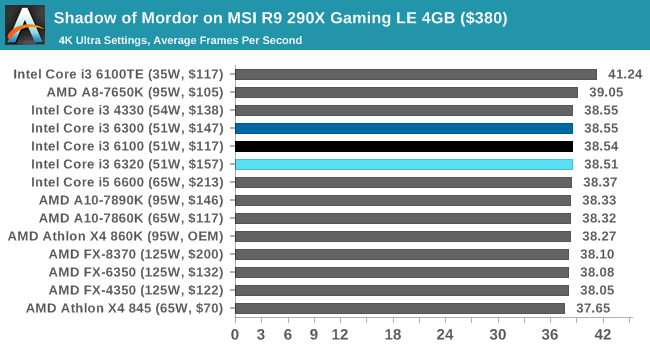
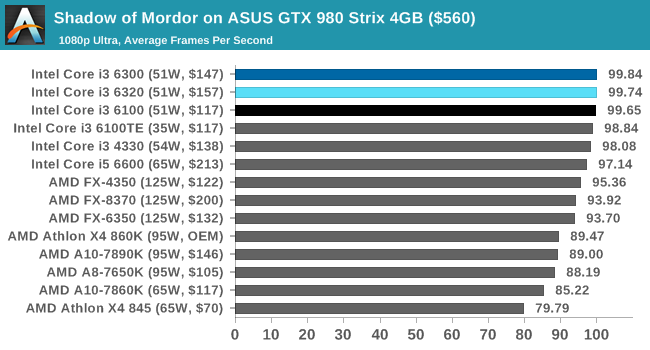
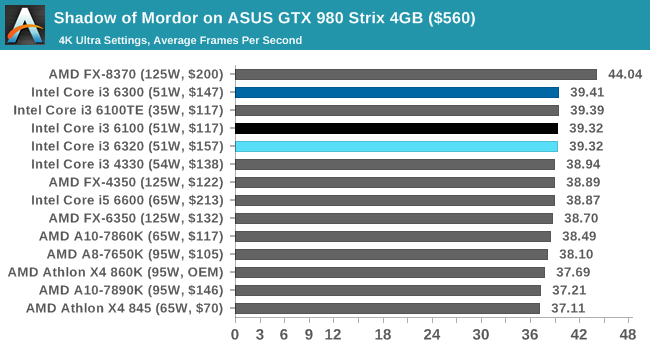
SoM is our most CPU agnostic benchmark of the set, such that as you increase the GPU power and the resolution, the CPU matters less to the performance. This is why at 4K Ultra, with both the AMD and NVIDIA discrete GPUs, the $70 CPU from AMD is within 2-3% for average frame rates.
However, it should be noted that the CPU power matters more when (a) an AMD discrete GPU is being used, or (b) lower resolutions. In both cases, the AMD FX CPUs are more likely to match up with Intel's Core i3, which sit at the top of the pack.











94 Comments
View All Comments
Samus - Tuesday, August 9, 2016 - link
^This.I love WinRAR, but even a blind test will demonstrate 7zip to be faster, especially at compression. Decompression is often storage limited unless you have a good RAID or PCIe SSD.
plopke - Monday, August 8, 2016 - link
I bought a core i3 6300 for my parents but only paid the price of a i3 6100 around 109 euro, the price gap is so big for such a small performance increase some vendors decided just to dump them out of their inventory.ShieTar - Monday, August 8, 2016 - link
Nice review. Any chance that the Pentiums and maybe even Celerons will be added to the comparison?Everybody reviews the i5&i7, but it's really hard to get any feel on how fast (or slow) the very cheapest Intel CPUs really are.
fanofanand - Tuesday, August 9, 2016 - link
I second this, I see a lot of inexpensive devices running low-end Intel parts and it sure would be nice to see how they stack up.jaydee - Monday, August 8, 2016 - link
Any attempts at trying Quicksync with the Skylake i3?AndrewJacksonZA - Wednesday, August 10, 2016 - link
+1 on the Quicksync please.elbert - Monday, August 8, 2016 - link
The i3's should have been removed from the desktop line up a long time ago. Quad cores come out over 10 years ago and Intel is still trying to sale dual cores for the desktop. Its really a testament to how tight a hold Intel's monopoly is on the PC business. Currently the hold that is killing the PC business.DanNeely - Monday, August 8, 2016 - link
The persistence of dual core hardware says more about the failure of most software to benefit from larger numbers of cores. Unless you've got at least 3 big threads running in parallel the extra physical cores of the i5/7 only serve to drive up manufacturing costs and power consumption.FunBunny2 - Monday, August 8, 2016 - link
-- The persistence of dual core hardware says more about the failure of most software to benefit from larger numbers of cores.the number of embarrassingly parallel user space applications continues to be stuck at a couple.
Ratman6161 - Monday, August 8, 2016 - link
But, for all those that are just web surfing, reading email, and typing Word documents, how much parallelism do they need? A while back I refurbished a couple of Core 2 duo laptops from about 2009. Upgraded them from 2GB to 4BB of cheap ram and slapped an el-cheapo SSD in place of the old 5400 RPM disk drives and they felt like new machines. For the people doing the sorts of tasks I mentioned above, they are more than good enough - even an i3 is overkill for the task.